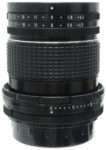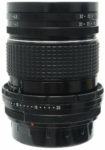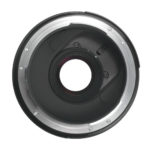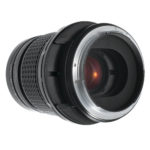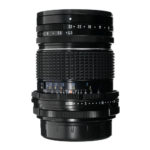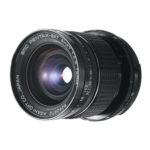smc Pentax 6×7 75mm F/4.5 Shift
Shift lens • Film era • Discontinued
- Announced:
- · 1979
- Production status:
- ● Discontinued
- Country of design:
- · Japan
- Original name:
- · ASAHI OPT. CO. SMC PENTAX-6X7 SHIFT 1:4.5 75mm
- Class:
- · Slow 6x7 medium-format shift lens
- · Professional model (Top class)
- System:
- · Pentax 6×7 (1969)
Abbreviations
| SMC | Multi-layer anti-reflection coating is applied to the surfaces of lens elements. This anti-reflection coating increases light transmission, eliminates flare and ghosting, and maintains color consistence among all lens models. |
| SHIFT | Perspective Control. |
Model history (2)
| ■smc Pentax 6×7 75mm F/4.5 Shift | P | 9 - 8 | 0.70m | B82 | 1979 ● | |
| ■smc Pentax 67 75mm F/4.5 Shift | P | 9 - 8 | 0.70m | B82 | 1989 ● | |
Specification
| Optical design: | |
| Medium format 6x7 | |
| 75mm | |
| F/4.5 | |
| 9 elements in 8 groups | |
| Pentax 6x7 [84.95mm] (Inner mount) | |
| 60.9° | |
| Diaphragm mechanism: | |
Diaphragm type: | Preset |
Aperture control: | Preset ring + Aperture ring |
| 10 (ten) | |
| Focusing: | |
| 0.70m | |
| 1:7.14 | |
Focusing modes: | Manual focus only |
Manual focus control: | Focusing ring |
| Perspective control mechanism: | |
Shift range: | 0..20mm |
Tilt range: | Not available |
| Yes | |
| - | |
| Physical characteristics: | |
| 950g | |
| ⌀97×106.5mm | |
| Accessories: | |
| Bayonet-type 82 | |
Additional features: | Rear gelatin filter holder |
| Not available | |
| <No data> |
Sources of data
- Pentax 6x7 system booklet.
- Pentax 6x7 system booklet (II).
- Pentax 6x7 interchangeable lenses operating manual (PUB. 06361) (May 1984).
- Pentax cameras booklet (PUB. 06091, 40 pages) (March 1987).
- Pentax SLR cameras booklet (PUB. 050101) (September 1988).
Manufacturer description #1
Designed for the professional in architectural photography, this unique lens features a continuously variable shift movement up to 20mm off axis for complete control over the degree of correction plus a full 360 lens barrel rotation. Exclusive Super-Multi-Coating minimizes flare and enhances resolution, contrast and color balance.
Filter size: 82mm threaded or bayonet. Gelatin filter holder in rear section of mount.
Manufacturer description #2
Your SMC Pentax 6x7 75mm shift lens is of great value for architectural, scenic and general purpose photography as well. Corresponding roughly to a 35mm lens in the 35mm format, it has the capability of correcting converging lines by making them perpendicular. lt features full 360-degree barrel rotation and offers a maximum shift of 2Omm, enabling creation of virtually an infinite variety of perspectives. You not only have the choice of correcting, but also of "over-correcting" or not correcting the subject in order to produce the most pleasing, striking or dramatic effect. Moreover, the precise shift capability of the lens makes it possible to create sweeping double-negative panoramas by joining together two corrected and perfectly matched negatives.
I. Operating the Shift Lens
For critical photography such as architecture, precise results and the most pleasing effects are obtained if shifts are made with the lens perpendicular to the film plane or tilted slightly upwards. For this reason, and due to the weight of the camera, use of a tripod is recgmmended. The lens may be mounted either vertically or horizontally to the tripod but a sturdy model should be used to prevent camera movement which causes misalignment.
Lens Rotation: The lens rotates a full 360 degree via the lens rotation ring. Click-stops are pvovided for every 3O degrees of rotation and inbetween settings may also be used. The green dot in front of the rotation ring indicates the direction in which the lens will shift as you turn the ring. With the dot at the top, the lens will shift upward (simultaneously the image in the viewfinder will move downward); with the dot at the bottom, the lens moves downward and the image upward; when the dot is located 90 degrees to the left, the lens moves horizontally to the left, etc.
Shifting: Because the lens rotates fully, two shift scales (with clickstops at 1 millimeter intervals) are provided to facilitate checking the degree of shift. As you turn the shift ring the amount of shift is indicated by the white index dot on the shift scale.
II. Correcting for Converging Lines
When set for zero millimeters shift, the shift lens will function as a normal 75mm wide-angle lens. Thus, when tilted upward, lines will converge at the top, conversely, when the lens faces downward (as when photographing from the top of a tall building) lines will converge at the bottom; when the camera is level lines will converge to the right or left in accordance with the direction the lens is moved off a perpendicular axis from the subject.
Whenever desiring to correct for converging lines, the lens must be shifted in the direction in which the lines converge. lf the lines appear to converge at the top as when photographing a tall building, for example, proceed as follows:
1. Turn the lens rotation ring so that the green dot is facing upward (the same applies whether the camera is mounted horizontally or vertically on the tripod).
2. Sight the subject through the viewfinder and slowly rotate shift ring counterclock- wise. As the shift ring is rotated, the lens will shift upward and the image in the viewfinder will simultaneously move downward.
3. Recenter the image in the viewfinder (you will find that the lines no longer converge to the same extent). Continue shifting the lens and recentering the image until the lines appear perpendicular.
Notes: When the desired shift cannot be obtained at maximum 2Omm shift, tilt the camera upward so that the axis inclines slightly; this will enable you to include the subject in the viewfinder, although lines will not be perfectly perpendicular. lf greater correction is still desired, back away from the subject to the point where where the desired correction can be obtained with the optical axis remaining perpendicular to the subject (excess can be trimmed later during enlarging).
Aperture Setting: Although the 6x7 shift lens does not feature an automatic diaphragm, it features convenient open-aperture viewing by means of the combined use of a special preset ring in conjunction with the aperture ring. First, preset the shooting aperture, f/11 for example, on the preset ring by aligning f/11 with the aperture index dot. Then, set the aperture ring to f/4.5 for bright viewing. Next, after focusing and composing, rotate the aperture ring to the right until it stops in line with the preset ring. Now, proceed by making a stopped down exposure measurement and taking the picture.
Note: Shifting up until the point of shutter release should be carried out at open aperture. Because of the effects of shifting, shooting apertures when the lens is stopped down should be f/8 or f/11 or as near to these as possible. Conversely, if the lens is stopped down farther (to f/16, f/22, etc.) some loss of sharpness will result because of defraction during shifting.
Exposure Measurement: Exposure will vary in accordance with the extent and direction of shift. Moreover, when the lens is shifted, the sensitivity of the exposure needle differs slightly from normal. To compensate for this, with the camera mounted horizontally, underexpose 1/2 stop; conversely, with the camera mounted vertically, overexpose 1/2 stop. Another method is to frame the subject first and take the exposure reading, then make appropriate compensation for shifting. Because shooting conditions vary from photo to photo, your own experience will produce the best results in compensating for lens shift.
III. "Emphasizing and Overcorrecting"
In addition to correcting for converging lines at the top by shifting the lens upward, the shift lens can also be shifted downward (reverse shift) to emphasize or exaggerate the degree to which lines converge; for example, to apparently increase the height of a tall building, or the length of a models legs. Moreover, when an 8mm upward shift is required to make the converging lines of a building appear perpendicular, an overshift of 15mm will cause the lens to converge in the opposite direction for different emphasis. By employing the various shifting techniques, one can create new perspectives in order to achieve the most dramatic and pleasing effect.
IV. Panoramics
Sweeping panoramics in which the picture format is effectively doubled horizontally from 6 x 7 to 6 x 14 are easily created with the SMC Pentax 75mm shift lens. Panoramics appear most attractive when made in the horizontal format; thus, the camera should be mounted to the tripod horizontally. Also, keep the camera perfectly level if you desire to keep lines from converging.
1. Shift the lens completely (20mm) to the left, and make the first exposure.
2. Next, rotate the lens 180 degrees so that the 20mm shift is on the right, and make the second exposure (rotating the lens and advancing the film should be carried out as gently as possible to prevent camera movement, which will result in mismatching of the two photographs).
3. Prints can later be made from the two negatives. The portions which overlap are removed, forming two perfectly matched negatives which are joined together to make one panoramic view.
Filters
In addition to accepting both 82mm screw-in type and bayonet-type filters which fit over the front of the lens, the 6 x 7 shift lens also features a gelatin filter clip at the rear which accepts gelatine filter squares, trimmed to size and inserted.
Other shift lenses in the Pentax 6×7 system
| ■Pentax 6x7 mount (1) | |||||||||
| smc Pentax 67 75mm F/4.5 Shift | P | 9 - 8 | 0.70m | B82 | 1989 ● | ||||

